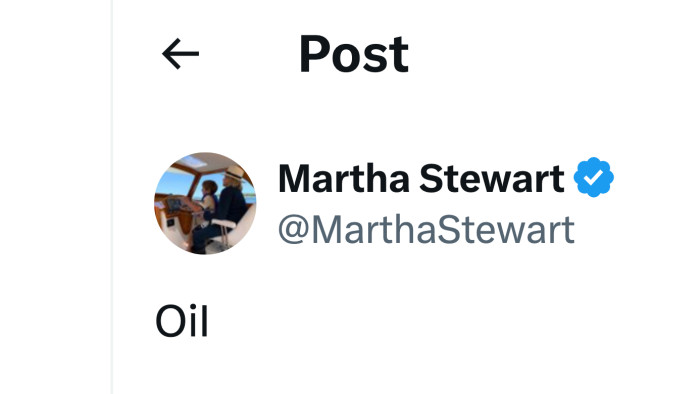Unlock the Editor’s Digest for free
Roula Khalaf, Editor of the FT, selects her favourite stories in this weekly newsletter.
“Contango” evokes images of dusky dancers from La Boca in Buenos Aires. If only things were that romantic. Instead, it refers to the situation that occurs while using financial futures contracts in which assets are cheaper today than a later point in time.
In commodity markets, a futures curve in contango will encourage traders to buy, say, crude oil at today’s price, place that in storage and lock in a higher price by selling futures contracts at some point in the future. That assumes there is sufficient storage space and financing to do all this.
The Trump administration’s cack-handed trade tariff policy announcements, particularly those involving China, have made everyone a bit jumpy about oil demand. The Opec+ decision in early April to lift oil production by 411,000 barrels per day from May, nearly triple the expected amount, only added fear of oversupplied oil markets.
All this has meant near-term oil prices keep falling, which sounds bearish. But the reality is that the oil curve’s shape suggests a more positive outlook for oil than one might think.
Traders care little about the direction of the spot (or flat) price of commodities such as oil. What grabs their attention is the behaviour of the futures curve and whether the price slopes upward (contango) or downward (backwardation). Usually, a curve in contango encourages inventories to build up and appears during bearish periods. Backwardation implies the opposite: positive near-term demand for crude, and with that low stocks of oil.
For most of the last seven years, the oil curve has been in backwardation. Past cuts to production by Opec+ have helped to maintain this situation. As a proxy for the curve, look at the historical spread between the near-term futures price and that for one year away. A negative difference (backwardation) has persisted for years, apart from during the pandemic year of 2020.
That suggests concern about a lack of supply of the stinky black stuff. Yet the US-China trade stand off has negative demand implications for both economies, the world’s two largest oil consumers. More supply is coming from the Opec+ producers. Shouldn’t the curve be in contango as oil inventories build up?
Certainly there are plenty of bears out there. Here’s what Citi’s oil team wrote earlier this month:
Physical oil markets will likely bear the brunt of the trade tariff related real activity shock in the coming weeks and months, with flat prices and structure [the oil curve] likely to move lower. We recently brought forward our bearish [second half 2025] Brent price $60/bbl forecast to the 0-3-month view, in a timely response to reciprocal tariffs.
And even by weird standards, things are weird. As Morgan Stanley analysts wrote in a note on Tuesday:
The Brent forward curve has an unusual shape at the moment: downward sloping across the first nine contracts and upward sloping thereafter… This is so unusual that, in fact, there is little historical precedent for this.
There are historical examples where the curve is downward sloping right at the very front, say between the 1st and 2nd contract, and then turns upward-sloping thereafter. However, in ~30 years of historical data, there has not been another period when the forward curve showed a ‘smile’ the way it currently does, with the low point around the 9th month contract.
Oil shocks in the past have had an immediate effect on demand and supply. Remember the negative prices of oil in early 2020, when supply appeared to overwhelm storage capacity? Things are different today.
Firstly, global inventory is pretty low. As an example, the 25mn barrels in storage at Cushing, Oklahoma — an important hub for the US oil benchmark traded at Nymex — represents a 19-year low for this time of year. Secondly, the profitability of oil refiners is healthy enough to keep their demand for crude oil inputs steady.
Valerie Panopio at Rystad Energy points out that refiners are doing pretty well as their profitability is above the ten year average. A spread of the Brent crude price against the prices of refined products — petrol and diesel — made from a barrel of oil gives an indication of the profitability.
“People worry about future oil demand,” says Kitt Haines, in charge of oil research at Energy Aspects:
But the low level of [oil inventory] and [stable] refining margins make this a strange situation. Unlike the global financial crisis or Covid periods, we can see this bad period [for oil] coming but we can’t time it.
Joel Hanley at S&P Global Commodity Insights agrees:
There’s definitely a sense that weaker demand growth expectations and potential for more supply will weigh heavily on the oil market, and potentially lead to a contango.”
The problem is that everyone has waited for Opec + to increase production for a year or more. Worse, different traders and investors, with sometimes opposing views, are creating a weird situation.
“You have different players on different parts of the curve. There are a lot of [commodity trading advisers] pushing down the flat price. They’re trading the most liquid two front months,” says Ryan Fitzmaurice, an oil trader at Marex. “Then others are net long given the oil curve’s backwardation. Then, later in the curve, some traders are playing the contango.”
To confuse matters more, between December 2025 and 2026 the curve slopes upward in contango.
Opec+ will not want the full oil curve to shift into contango as it would encourage big inventory builds. “With the backwardation, Opec+ controls oil inventories,” points out Panopio at Rystad. “But if contango comes through then the traders will control oil stocks.”
Bad news for Opec.
https://www.ft.com/content/e35c2b2f-8393-46b5-a28f-8bd5978b0eae


